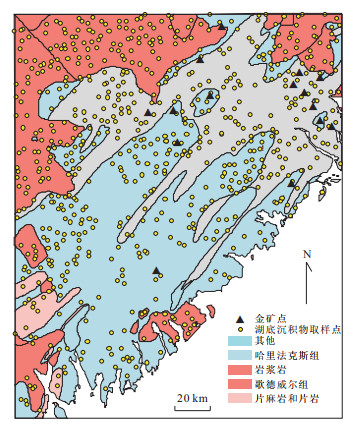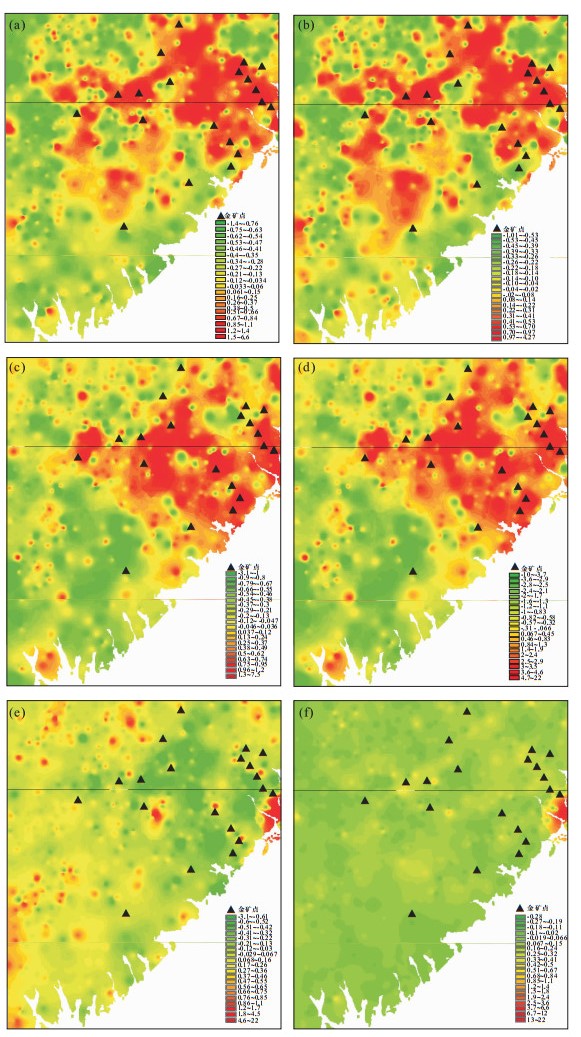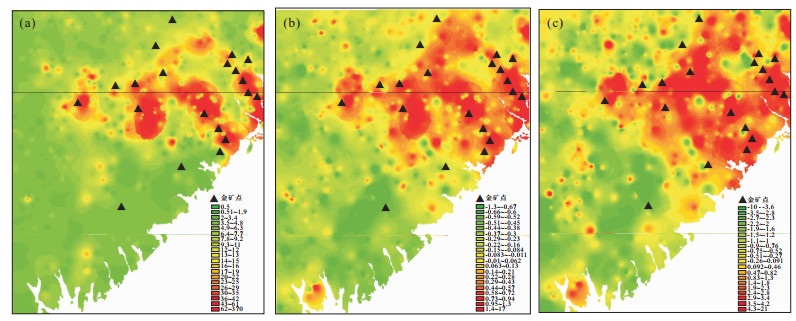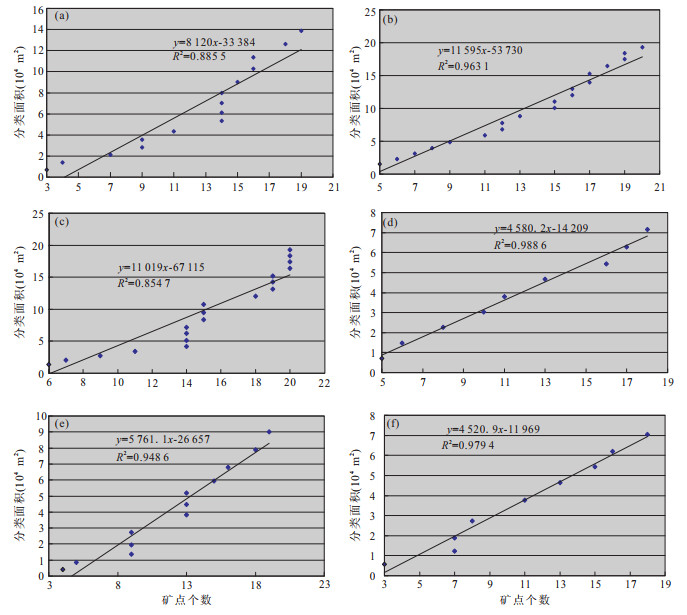Application of Structural Equation Modeling in Geochemical Data Analysis
-
摘要: 为了实现通过确定地球化学组合元素来反映成矿异常, 本文在主成分分析模型的基础上, 引入了新的结构方程模型(SEM).与主成分所不同的是, 结构模型综合了经典统计方法中的因子分析和路径分析方法, 以与研究对象具有较好的拟合度为标准来确定最优解, 并通过模型最优解来确定新的成分组合, 因此结构模型所确定的成分变量不一定是具有最大变化性, 而是与研究对象最接近的因子变量, 该因子能够更好地反映研究对象.介绍了结构方程模型方法的原理, 并利用加拿大Nova Scotia省西南部湖泊沉积物地球化学数据建立了与热液型金矿有关的地球化学元素结构方程模型, 研究了结构方程模型所给出的组合变量空间分布规律以及与金矿床的关系.与主成分分析方法所给出的计算结果进行对比发现, 结构模型所计算的与金矿相关的组合变量与矿床的空间相关性较高, 并且对金矿床(矿点)也具有较好的预测性.
-
关键词:
- 结构方程模型(SEM) /
- 主成分分析(PCA) /
- 变量相关性 /
- 路径分析 /
- 数学模型 /
- 数学地质 /
- 成矿预测 /
- 矿床
Abstract: In order to find a combination of geochemical elements reflecting the abnormal mineralization, this paper provides a method of structural equation modeling (SEM) for geochemical data processing based on principal component analysis (PCA). Different from the PCA, the structural equation model takes the favorable fitness with studying object as the criterion to determine the optimal solution, through which the new component will be determined; it is a combination of factor analysis and path analysis. Therefore, the component determined by the structural model is not necessarily the one with the largest variability, but the one closest to the object of study, which can thus better reflect the research target. This study not only describes the principle of structural equation modeling, but also makes use of it in the geochemical data analysis experiment. The geochemical data is measured from lake sediments samples obtained from the Southwest Nova Scotia, Canada, a model of geochemical elements related to the hydrothermal fluid gold mine is established. The spatial distribution law of the composite variables given by the structural model, and the relation between those variables and the gold deposits as well, is studied. A comparison with those of the PCA results shows that the factor variables related to the gold mine computed by the structural equation modeling are highly correlated to the space of the gold deposits, and they can also better predict the gold deposits. -
表 1 结构方程变量表
Table 1. Variables in SEM
符号 维度 说明 x q×1 ξ的观察变量 y p×1 η的观察变量 ξ n×1 外因潜在变量 η m×1 内因潜在变量 δ q×1 x变量的测量误差 ε p×1 y变量的测量误差 ζ m×1 内因潜在变量的误差 β m×m 内因潜在变量(η)间的系数矩阵 γ m×n 外因潜在变量(ξ)与内因潜在变量(η)相关联的系数矩阵 ϕ n×n 外因潜在变量协方差矩阵 λx q×n x与外因潜在变量(ξ)间的关联系数矩阵 λy p×m y与外因潜在变量(η)间的关联系数矩阵 表 2 潜变量F1,F2,F3回归系数
Table 2. Regression coefficient for F1, F2, F3
观察变量 潜变量1 潜变量2 潜变量3 Ag -0.03 0.04 -0.01 Au 0.09 0.02 -0.01 F 0.63 0.74 0.11 Li 0.89 0.04 0.03 Nb 0.70 -0.23 -0.03 Pb 0.34 0.16 0.11 Rb 1.04 -0.46 0.07 Sb 0.00 0.12 0.05 Sn 0.38 -0.15 0.00 Th 0.71 0.20 0.08 Ti 0.94 -0.25 1.52 Zn 0.12 0.84 -0.02 Zr 0.97 -0.56 -0.01 表 3 模型适配度检验结果
Table 3. Goodness of fit statistics
适配统计变量 模型值 良好适配值 χ2/df 28.70 0.00~5.00 RMR 0.05 0.00~0.05 RMSEA 0.10 0.08~0.10 GFI 0.90 0.90~1.00 检验结果表明,除卡方自由度比外,其他统计检验都能基本支持模型假设成立. -
Agterberg, F.P., Bonham-Carter, G.F., Wright, D.F., 1990. Statistical pattern integration for mineral exploration. In: Gaal, G., Merriam, D.F., eds., Computer Applications in Resource Estimation, Prediction and Assessment for Metals and Petroleum. Pergamon Press, Oxford. Anderson, J.C., Gerbing, D.W., 1988. Structural equation modeling in practice: a review and recommended two-step approach. Psychological Bulletin, 103(3): 411-423. doi: 10.1037/0033-2909.103.3.411 Anderson, J.C., Gerbing, D.W., 1992. Assumptions and comparative strengths of the two-step approach. Sociological Methods Research, 20(3): 321-333. doi: 10.1177/0049124192020003002 Bagozzi, R.P., 1981. Evaluating structural equations models with unobservable variables and measurement error: a comment. Journal of Marketing Research, 18 (3): 375-381. Bentler, P.M., 1990. Comparative fit indexes in structural models. Psychological Bulletin, 107(2): 238-246. doi: 10.1037/0033-2909.107.2.238 Bentler, P.M., Bonett, D.G., 1980. Significance tests and goodness of fit in the analysis of covariance structures. Psychological Bulletin, 88 (3), 588-606. doi: 10.1037/0033-2909.88.3.588 Cheng, Q.M., Bonham-Carter, G., Wang, W.L., et al., 2011. A spatially weighted principal component analysis for multi-element geochemical data for mapping locations of felsic intrusions in the Gejiu mineral district of Yunnan, China. Computers & Geosciences, 37(5): 662-669. doi: 10.1016/j.cageo.2010.11.001 Chin, W.W., 1998. Issues and opinion on structural equation modeling. Mis Quarterly, 22(1): 7-16. http://www.researchgate.net/profile/Wynne_Chin/publication/220260360_Issues_Opinion_on_Structural_Equation_Modeling/links/09e415149251134c0a000000.pdf Cook, T.D., Campbell, D.T., 1979. Quasi-experimentation: design and analysis issues for field settings. Houghton Mifflin, Boston. Hair, J.F., Anderson, R.E., Tatham R.L., et al., 1998. Multivariate data analysis (5th ed. ). Prentice Hall International, UK. Hu, L., Bentler, P.M., 1998. Fit indices in covariance structure modeling: sensitivity to under parameterized model misspecification. Psychological Methods, 3(4): 424-453. doi: 10.1037/1082-989X.3.4.424 Hulland, J., Chow, Y.H., Lam, S., 1996. Use of causal models in marketing research: a review. International Journal of Research in Marketing, 13(2): 181-197. doi: 10.1016/0167-8116(96)00002 Luo, X.R., Wen, M.L., Ouyang, F., 2012. Reconnaissance geochemical. Metallurgical Industry Press, Beijing (in Chinese). McQuitty, S., 2004. Statistical power and structural equation models in business research. Journal of Business Research, 57(2): 175-183. doi:10.1016/ S0148-2963(01)0030-0 Wen, Z.L., Hou, J.T., Mash, H.W., 2004. Structural equation modeling: cutoff criteria for goodness of fit indices and chi-square test. Acta Psychologica Sinica, 36(2): 186-194 (in Chinese with English abstract). Xie, X.J., 1979. Regional geochemical exploration. Geological Publishing House, Beijing (in Chinese). Xu, Y.G., Cheng, Q.M., 2001. A fractal filtering technique for processing regional geochemical maps for mineral exploration. Geochemistry: Exploration, Environment, Analysis, 1(2): 147-156. doi: 10.1144/gechem.1.2.147 罗先熔, 文美兰, 欧阳菲, 2012. 勘察地球化学. 北京: 冶金工业出版社. 温忠麟, 侯杰泰, 马什赫伯特, 2004. 结构方程模型检验: 拟合指数与卡方准则. 心理学报, 36(2): 186-194. https://www.cnki.com.cn/Article/CJFDTOTAL-XLXB200402009.htm 谢学锦, 1979. 区域化探. 北京: 地质出版社. -









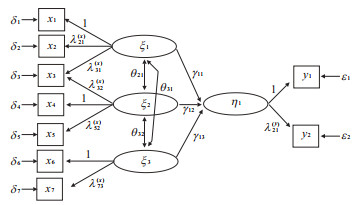
 下载:
下载:
